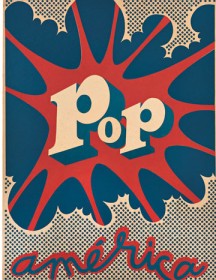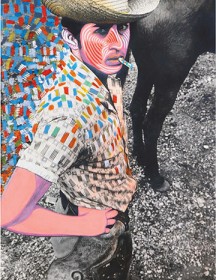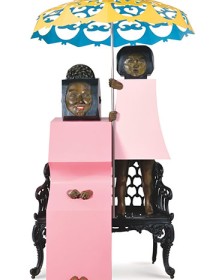The Block Museum celebrates an exuberant Latin American history of Pop Art
‘Pop América, 1965–1975’ opens The Block’s year of Global Modernisms
Chicago audiences will discover an expanded history of Pop Art when The Block Museum of Art at Northwestern University opens the exhibition “Pop América, 1965–1975” this fall. Running Sept. 21 through Dec. 8, the bilingual exhibition challenges and reframes familiar notions of Pop Art by bringing together artists from North and South America, as well as the Caribbean.
The Block Museum is the final and largest metropolitan area venue for the touring exhibition, which was organized by Duke University’s Nasher Museum of Art.
Winner of the inaugural Sotheby’s Prize, which was established to honor exhibitions that explore overlooked or under-represented areas of art history, “Pop América” is the first exhibition to unify Latin American and Latinx expressions of Pop.
The exhibition examines how Pop Art’s bold and colorful imagery, references to mass culture and representations of everyday objects, signs and symbols, were embraced by artists working across the hemisphere. “Pop América” also takes a timely and critical look at the social and political impulses behind Pop Art from the mid-1960s through the mid-1970s.
“We are proud to bring this groundbreaking exhibition to the campus of Northwestern University and to Chicago audiences,” said Lisa Corrin, The Block Museum’s Ellen Philips Katz Director. “It feels timely to consider the ways in which ideas, politics and culture have long cross-pollinated across the Americas resulting in innovative and beautiful works of art. ‘Pop América’expands the canon of art history and our understanding of Pop, shifting the focus away from what was happening in London and New York, to include other expressions of Pop sensibilities.”
Exhibition artists: new revelations and familiar faces
“Pop América” features nearly 100 artworks by more than 40 artists working in Argentina, Brazil, Chile, Colombia, Cuba, Mexico, Peru, Puerto Rico, Venezuela and the United States, sparking a reconsideration of Pop as a U.S. and European phenomenon. The exhibition reshapes debates over Pop’s perceived political neutrality and aesthetic innovations, creating vital dialogues that cross national borders.
The artists in the exhibition include Antonio Dias, Rubens Gerchman, Roy Lichtenstein, Marisol, Cildo Meireles, Marta Minujín, Hugo Rivera-Scott and Andy Warhol, among others. United by their use of Pop’s visual strategies, these artists have made bold contributions to conceptualism, performance and new-media art, as well as social protest, justice movements and debates about freedom.
“This exhibition will expand both the idea of what Pop Art was, and for many visitors will bring to light what was happening in Latin America in the mid-1960s-1970s,” said Corinne Granof, academic curator at The Block Museum.
“A lot of the artists included in the exhibit will be familiar, especially Andy Warhol, Robert Indiana, Roy Lichtenstein and Latin America artists, such as Marisol,” said Granof. “However, the exhibit also includes work by Brazilian artists Rubens Gerchman, Amaral and Cildo Meireles, Columbian artist Beatriz González, Raul Martinez from Cuba and Marta Minujín from Argentina. Many of these artists are not as widely known, and it will be a revelation to encounter their impactful works that play off Pop in compelling and powerful ways.”
Global Pop, global modernisms
“Pop América” reinforces trends within art history to think globally and across borders to find commonalities among artists in different regions. The exhibition is one of several in recent years that have reexamined Pop Art and put it into a global context, including “International Pop” (Walker Art Center, 2015) and “The World Goes Pop” (Tate, 2015–16). “Pop América” also compels visitors to rethink concepts of “America,” a question that is especially relevant today. The addition of the accent over the é in América contests the presumed primacy of the United States in artistic, economic and political realms, and reinforces a greater sense of transnational unity. At the same time, the exhibition has the potential to open up conversations about nationality, borders and migration.
The Block Museum of Art has announced that the entirety of its 2019–2020 exhibition schedule will be devoted to the idea of “Global Modernisms,” and this exhibition is the first within that framework. “Pop América” is one of several exhibitions that explore new ways of looking at modernist approaches that were thriving beyond Europe and the United States.
Upcoming exhibitions include aesthetic innovation throughout the Arab World and the Middle East, Turkey, India and -- with “Pop América” -- Latin America. The Block Museum is committed to looking at art across time, culture and place, and the 2019–20 schedule promotes new vantage points from which to consider artists’ response to modernity.
The politics of Pop
The exhibition title is drawn from a 1968 print by Chilean artist Rivera-Scott with its verbal cue to “pop” -- or to explode -- the idea of America. While the print itself uses familiar visual strategies from iconic Pop artworks, such as Lichtenstein’s “Explosion”(1967) -- including an animated comic book-like stylized text, flat colors and Ben-Day dots -- the emphasis on action that Rivera-Scott conveys through the expression “Pop América” is highlighted throughout the exhibition.
The works are divided into sections that allow visitors to think in active terms, including “Facing América,”“Mediating América,” “Consuming América,” “Liberating América” and “Fashioning América.” In many cases, Latin-American and Caribbean Pop art movements engage with material culture in ways familiar from the U.S. context, but reveal different political weight in the context of oppressive military regimes, state censorship, economic challenges and leftist resistance movements. The exhibition sheds light on these stylistic parallels, as well as the specific political circumstances of the individual countries it represents.
The exhibition is groundbreaking in its exploration of the way in which Pop Art was used throughout the Americas as an intentional strategy for communicating sensitive, politically challenging content.
“In North America, Pop Art often emphasized the superficial, surface and appearance, an idea reinforced by such iconography as celebrities and fashion, consumer products, Coke bottles and Campbell’s soup cans, comic books -- any motif that comes from the world of popular culture,” Granof said. “This playful spirit of Pop Art is also apparent in iterations of Pop from the Global South. However, using similar frames of reference, there is sometimes a more political inflection or outright critique that comes through in the Latin American expressions of Pop. At the same time, looking at this work through a different lens, we start to see the stronger political tendencies in U.S. Pop Art.”
Public tours and programming
Free tours of the exhibition will be held Sundays at 3 p.m. and on select Tuesdays at noon. Spanish-language tours will be held Saturdays at 3:30 p.m. on Oct. 19 and Nov. 9. More information on “Pop América” tours is available on The Block Museum website.
A full season of free cinema and programming will delve deeper into the topics of the exhibition and several programs, including the Sept. 28 Opening Celebration, will be presented in partnership with Chicago’s National Museum of Mexican Art (NMMA), one of the most prominent first-voice institutions for Mexican art and culture in the United States. The “Pop América” collaboration is the first in an ongoing partnership between NMMA and Block Museum aimed at expanding NMMA’s reach to Chicago’s Northshore, and sharing the wealth of NMMA’s cultural knowledge with Northwestern University’s audiences.
Download Block Museum’s complete fall program guide.
Fall programming highlights:
Opening Celebration: Pop América Pop In
Saturday, Sept. 28, noon to 4 p.m.
The opening day “Pop In” offers celebration activities for all ages including printmaking with Instituto Gráfico de Chicago, radio broadcast with Yollocalli Arts Reach, live son jarocho music and exhibition tours.
Contesting Freedom: "Pop América, 1965–1975” a Conversation with Curator Esther Gabara
Wednesday, Oct. 2, 6 p.m.
Hear directly from Esther Gabara, curator of Pop América, about the artists from across the hemisphere who shared dreams and struggles over the idea of a singular América.
Cesáreo Moreno: Mi Casa es Su Casa
Wednesday, Oct. 16, 6 p.m.
This guided tour will examine select works in “Pop América” created by Mexicans on both sides of the border to uncover similarities between them.
América Now: Chicago Artists in Dialogue
Wednesday, Oct. 30, 6 p.m.
An in-depth conversation with three Chicago artists who will consider how ideas and approaches from Pop América remain relevant in our contemporary moment.
Ism, Ism, Ism: Experimental Cinema in Latin America
Oct. 3 – Nov. 1
Block Cinema and Chicago partner locations
This groundbreaking touring film series offers the first comprehensive survey of Latin America’s vibrant experimental film history. Screening partners include Nightingale Cinema (1084 N. Milwaukee Ave.), Filmfront (1740 W. 18th St.), Comfort Station (2579 N. Milwaukee Ave.) and ACRE (1345 W. 19th St.).
Credits and catalogue
“Pop América, 1965-1975” is co-organized by the Nasher Museum of Art at Duke University, Durham, North Carolina, and the McNay Art Museum, San Antonio, Texas. The exhibition is curated by Esther Gabara, E. Blake Byrne associate professor of romance studies and associate professor of art, art history and visual studies at Duke University. At the Block Museum, the exhibition is curated by Corinne Granof, curator of academic programs.
Support for “Pop América, 1965–1975” is provided by the Sotheby’s Prize and The Andy Warhol Foundation for the Visual Arts. Additional support is provided by the Institute for Studies on Latin American Art (ISLAA) and its President and Founder Ariel Aisiks. The project is supported in part by an award from the National Endowment for the Arts and the Alumnae of Northwestern University.
“Pop América, 1965–1975” also is a bilingual (English/Spanish) 216-page catalogue published by Duke University Press that explores Pop art as a hemispheric art movement. Reconstituting a network of artists who were active some 50 years ago, “Pop América” explores how Latin American and Latino/a/x artists adapted familiar languages of mass media, fashion and advertising to create provocative artwork in a range of mediums.
The Block Museum is a member of the Northwestern Arts Circle, which brings together film, humanities, literary arts, music, theater, dance and visual arts.
Multimedia Downloads
Photo Assets


